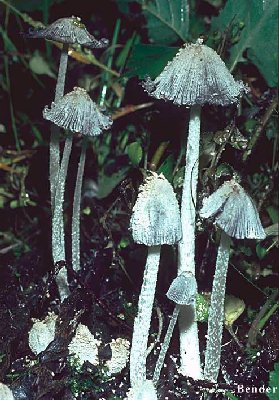Macroscopic features |
Pileus up to 15 x 10 mm when still closed, up to 25 mm when expanded, subglobose to oblong, densely covered with mealy to hairy floccose veil, pale grey to mouse-grey. Lamellae free, white to black. Stipe up to 75 x 1-3 mm, whitish; base somewhat clavate. Smell strongly >narcotic=. |
Microscopic features |
Spores 9.0-13.3 x 4.8-6.7 µm, Q = 1.70-2.15, av. Q = 1.85, av. L = 11.3 µm, av. B = 5.9 µm, ellipsoid or ovoid, with conical base and rounded to somewhat truncate apex, dark red-brown; germ pore central, 1.4-1.6 µm wide; episporium strongly developed, smooth, up to 1.3 µm wide in places. Basidia 20-36 x 8-11 µm, 4-spored, surrounded by 3-5 pseudoparaphyses. Pleurocystidia 50-140 x 20-45 µm, utriform, oblong or subcylindric. Cheilocystidia 40-90 x 20-50 µm, (sub)globose, ellipsoid, oblong, utriform or subcylindric. Pileipellis made up hyphoid elements. Elements of veil up to 100(110) µm wide, made up of globose, warty cells connected with narrow, diverticulate hyphae. Clamp-connections indistinct, if present sparse. |
Habitat & distribution |
Rather common, on dung and on the ground. Wide-spread in Europe and probably other regions. |
Remarks |
Coprinus narcoticus can be recognised by the spores which have a conical base and wrinkled episporium and the strong >narcotic= smell. The species usually grows on vegetable refuse and less common on dung whereas C. radicans often do so. |

[Copyright © by ]

[Copyright © by Hans Bender jbe8995374@aol.com]